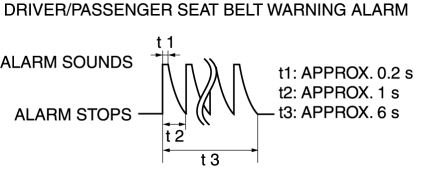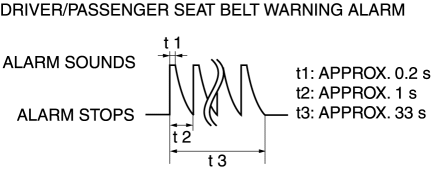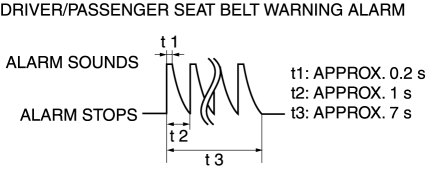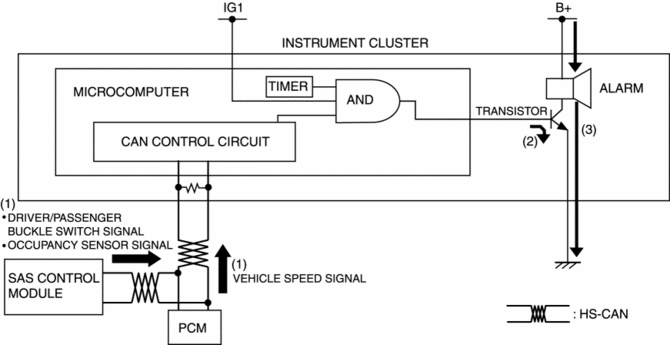Mazda CX-5 Service & Repair Manual: Seat Belt Warning Alarm
Purpose
-
The seat belt warning alarm warns occupants that a seat belt is not fastened.
Function
-
The instrument cluster sounds the seat belt warning alarm based on the following CAN signals:
-
Vehicle speed signal sent from PCM
-
Driver/passenger buckle switch signal, occupancy sensor signal sent from SAS control module
Driver/passenger seat belt warning alarm sound function
-
The driver/passenger seat belt warning alarm has a warning for when the vehicle is stopped, while the vehicle is being driven, and subsequent warnings while the vehicle is being driven.
-
When all of the following conditions have been met, the alarm sounds.
-
Ignition switch ON (engine off or on)
-
Driver/passenger buckle switch on signal (seat belt unfastened) is detected
-
Occupancy sensor on signal (occupant in passenger seat) is detected (passenger seat belt warning alarm only)
-
The driver/passenger seat belt warning alarm sound pattern is as shown in the figure.

-
When all of the following conditions are met, the alarm sounds.
-
Vehicle speed is approx. 20 km/h {12 mph} or more
-
Driver/passenger buckle switch on signal (seat belt unfastened) is detected
-
Occupancy sensor on signal (occupant in passenger seat) is detected (passenger seat belt warning alarm only)
-
The driver/passenger seat belt warning alarm sound pattern is as shown in the figure.

-
When all of the following conditions are met, the alarm sounds.
-
Vehicle speed is approx. 20 km/h {12 mph} or more
-
Occupancy sensor on signal (occupant in passenger seat) is detected (passenger seat belt warning alarm only)
-
After initial warning operates, buckle switch off signal (seat belt fastened) to on signal (seat belt unfastened) is detected
-
The driver/passenger seat belt warning alarm sound pattern is as shown in the figure.

-
Warning while vehicle is stopped
-
Warning while vehicle is being driven
-
Subsequent warning
Construction
-
The seat belt warning alarm sounds using the buzzer built into the instrument cluster.
Operation
1. The instrument cluster receives (1) the vehicle speed signal from the PCM, the driver/passenger buckle switch signal and occupancy sensor signal from the SAS control module when the ignition is switched ON (engine off or on).
2. The instrument cluster microcomputer turns the transistor on (2) based on each signal.
3. When the transistor turns on, a ground circuit with the alarm is established and the alarm sounds (3).

Fail-safe
-
Function not equipped.
 Power Steering Malfunction Indicator Light
Power Steering Malfunction Indicator Light
Purpose
The power steering malfunction indicator light warns the driver that there
is a malfunction with the electric power steering (EPS) system.
Function
If there is a malfunc ...
 Seat Belt Warning Light
Seat Belt Warning Light
Purpose
The seat belt warning light warns the driver that a seat belt is not fastened.
Function
The instrument cluster flashes/illuminates the seat belt warning light based
on t ...
Other materials:
Quick Release Connector (Emission System)
Purpose, Function
Serviceability has been improved by the easy disconnection/connection.
Construction
The following types of quick release connectors are used.
U.S.A. and CANADA
Except U.S.A and CANADA
Type A
An SST is not used with this type.
...
Ignition Switch
Push Button Start Positions
The system operates only when the driver is in the vehicle or within operational
range while the key is being carried.
Each time the push button start is pressed, the ignition switches in the order
of off, ACC, and ON. Pressing the push button start again from ON sw ...
Decoration Panel Removal/Installation
CAUTION:
Affix protective tape to the position shown in the figure.
1. Disconnect the negative battery cable..
2. Open the glove compartment.
3. Insert a tape-wrapped flathead screwdriver in the position indicated by the
arrow (1) in the figure and detach clip A.
4. ...
